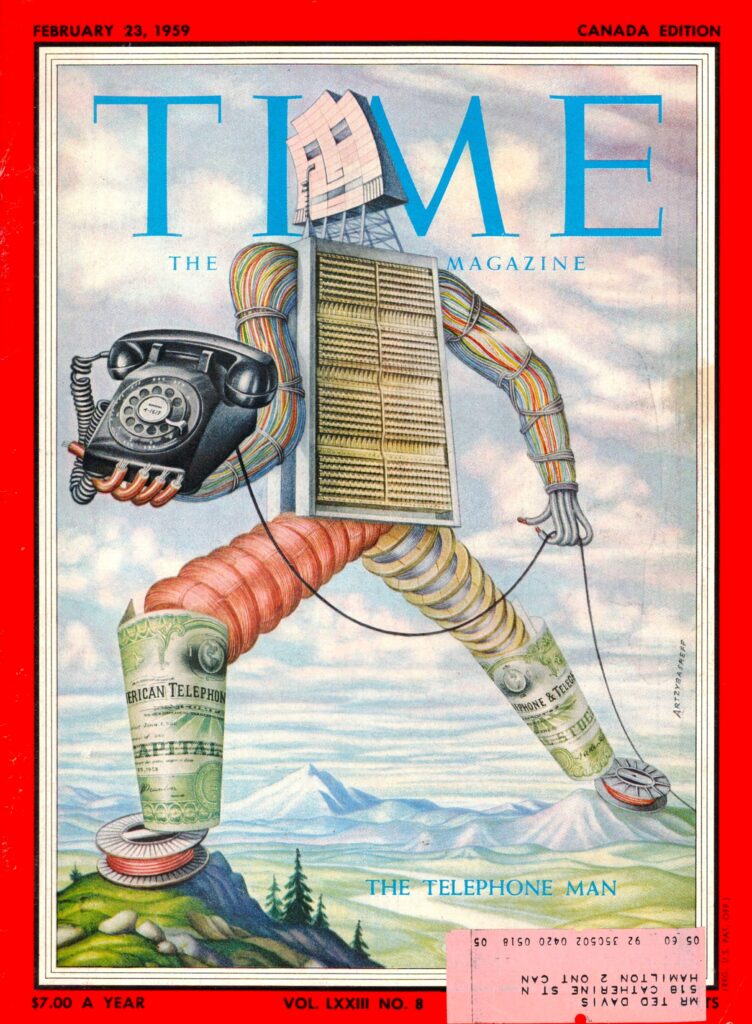Our vintage TIME magazine this week is from February 23, 1959 and features The Telephone Man on the cover. This was a time when communication technologies were rapidly advancing and people were still adjusting to this new more connected world.
We also look at a few other interesting articles and ads within this magazine, but there is much more between the pages. If you want to check out the rest for yourself, then you can find this issue and many more at PFTP Antiques.
The Telephone Man
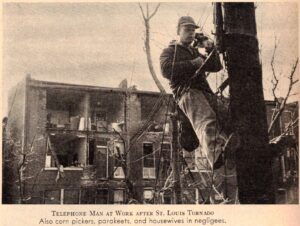 Night and day I keep singing—humming and thrumming:
Night and day I keep singing—humming and thrumming:
It is love and war and money; it is the fighting and the tears, the work and want,
Death and laughter of men and women passing through me, carrier of your speech,
In the rain and the wet dripping, in the dawn and the shine drying,
A copper wire.
—Carl Sandburg, Under a Telephone Pole
Cell phones are a standard item that most adults and many children have nowadays. These devices are much more than just a phone and for many of us they go where we go, hold an amazing amount of our information and keep us connected to the world around us. However, in 1959 telephone technology was still very new.
When this issue of TIME magazine was published, Washington was considered the world’s talkingest city with 70 telephones per 100 people. New York City was much lower with only 53.8 telephones per 100 people. This probably meant that most households had one home phone installed. I was surprised to read that some wealthy people already had phones installed in planes and cars.
AT&T Was the dominant phone company at the time, however, more than half the U.S. was being served by 3,789 independent telephone companies. One such company was so small that it serviced about 60 phones and was based out of a hotel room.
Telephones were gradually becoming more reliable. Laws were created to ensure people cleared party lines when there was an emergency. AT&T equipment was so trouble-free that the telephone man only had to come out for repairs about once every two years. There were often more problems due to damage caused by the public. For example, during New Year’s celebration in 1959, there were 148 cases of phone lines getting damaged when subscribers fired their shotguns out the window in celebration.
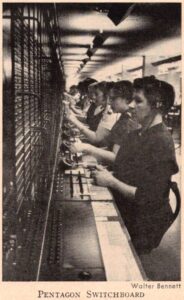 Phone systems were increasingly moving away from having operators connect calls. This was an issue that surprisingly met some resistance. Similar to scanning our own products at the store now, people didn’t want to give up the operator service because they felt that the consumer would be doing the operator’s job. Nevertheless, the change was well underway and about 94% of telephones were already on the dial system.
Phone systems were increasingly moving away from having operators connect calls. This was an issue that surprisingly met some resistance. Similar to scanning our own products at the store now, people didn’t want to give up the operator service because they felt that the consumer would be doing the operator’s job. Nevertheless, the change was well underway and about 94% of telephones were already on the dial system.
If someone has ever called you to try and sell something, you may have Bell to thank for it. Bell executives discovered that telephone sales girls sold 112% more than floor sales girls in department stores. They also did it at 51% less cost. As a result, telephone sales were emerging as a new use for the phone.
The future of telephones that was envisioned in 1959 has been realized and in many ways exceeded. Bell had already created a repertory dial phone, that automatically dialed frequently used numbers. Additionally, they were beginning to produce speaker phones that would allow a user to talk and listen from any point in a room.
Bell scientists were continuing to refine the telephone and consider new applications. They were starting to work towards miniature phones and it was noted that pushbutton phone could become standard if the public wanted it.
There was the idea that subscribers would be able to have frequently used numbers stored in a central telephone exchange. The subscriber would simply push a single code button to call that number.
They even envisioned something called Phone-vision! This technology would allow the subscriber to see and hear the caller they are talking with.
The ultimate dream in telephone service as envisioned by a former chief engineer of AT&T was that “Whenever a baby is born anywhere in the world, he is given at birth a telephone number for life. As soon as he can talk, he is given a watchlike device with ten little buttons on one side and a screen on the other. When he wishes to talk with anyone in the world, he will pull out the device and punch on the keys the number. Then, turning the device over, he will hear the voice of his friend and see his face on the screen, in color and in three dimensions. If he does not see him and hear him, he will know that his friend is dead.”
Kodak Camera
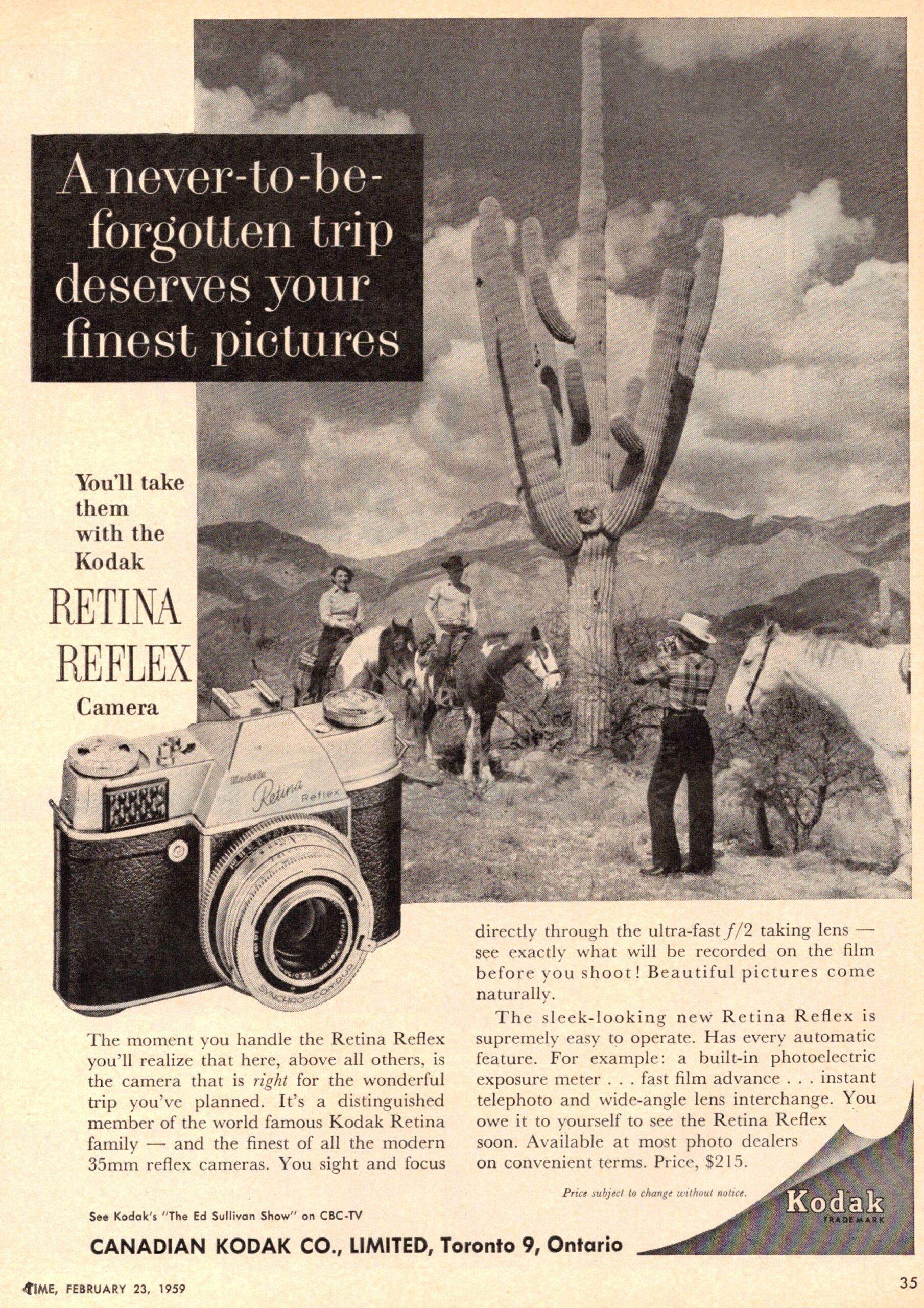
Ocean Exploration
During a time when most were looking towards space exploration, many scientists saw earth’s oceans as a more profitable option. The National Academy of Sciences developed a ten-year program with the intend of discovering what resource treasures the ocean held.
It was recommended that universities receive financial aid to set up oceanographic departments, fellowships for students and the construction of specialized research equipment. The cost of the program would be over $58,000,000 in 1960 and more than $650,000,000 over the ten-year plan.
Some of the specific projects this funding would help develop:
- Hard-shelled submarines that can operate down to the bottom of the ocean, learning much more by direct observation than can be learned by the instruments of surface ships.
- Development of high seas engineering techniques and equipment for sampling the ocean bottom and drilling deep holes in it. It has been known for years that rich deposits of manganese, nickel and cobalt cover much of the ocean bottom.
- A study of the possibilities of fertilizing the ocean surface water, so that more marine life can grow in it.
- Projects to transplant useful organisms, e.g., U.S. oysters or lobsters, from one part of the ocean to another.
- An elaborate system of drifting and anchored buoys that will report automatically and do for the ocean what weather observation stations do for the atmosphere over the land.
1959 Pontiac advertisement
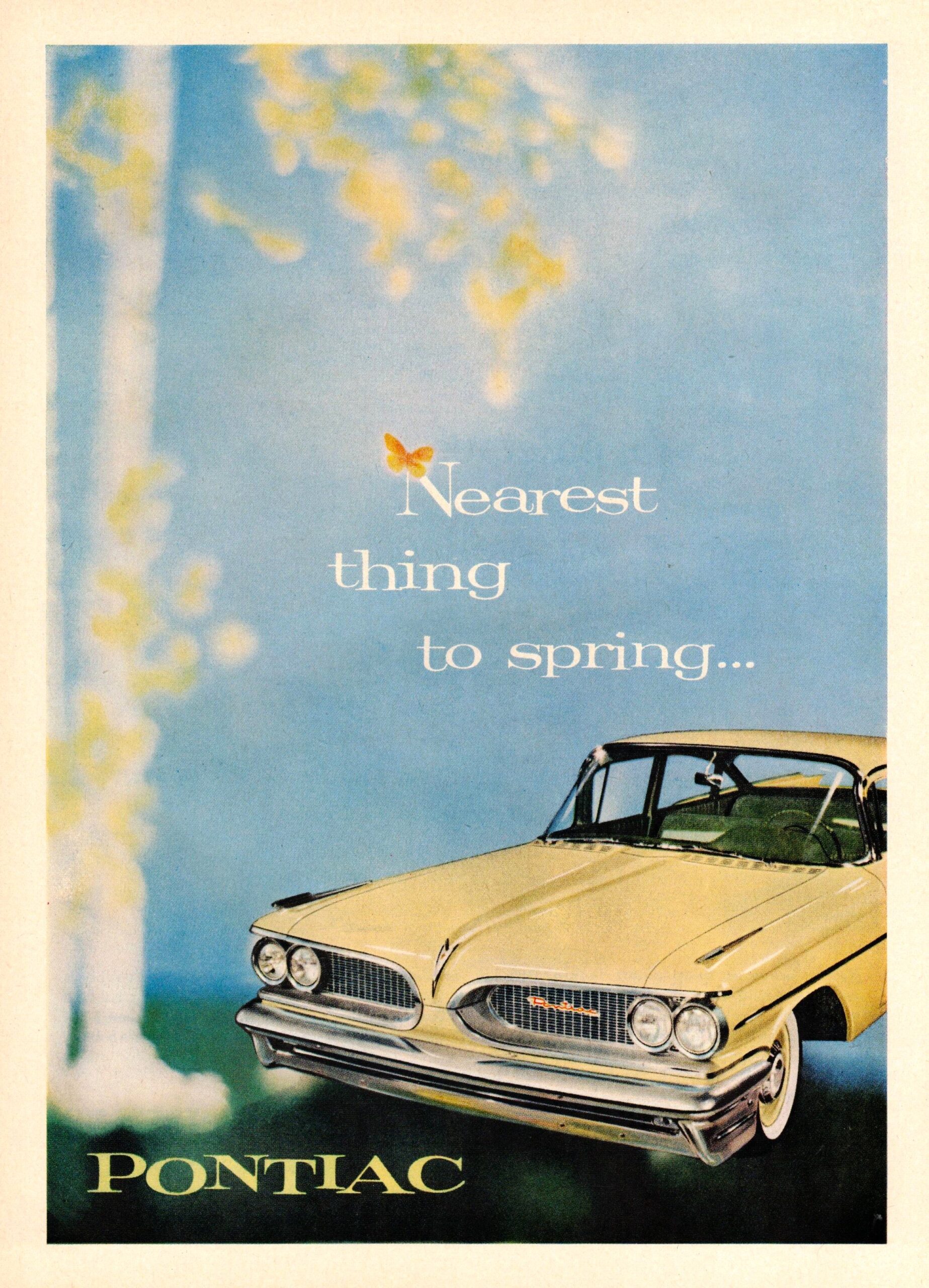
What Were They Thinking!
In 1959 medical professionals were aware that X-rays could be destructive to human tissue. This was a known fact since the early 1900’s. However, X-rays were still being unnecessarily being used as a cure-all treatment for many minor conditions.
A report in the New England Journal of Medicine stated that “patients continue to appear with permanent tissue destruction that has resulted from relatively recent radiation treatment of acne, plantar wart, eczema [and] superfluous hair.”
Doctors documenting the dangers of exposure to irradiation noted:
- Nearly half the patients suffered from persistent painful ulceration.
- Cancer appeared in 36—or 22%—of the cases.
- Of the ten patients who had been treated for acne, nine developed skin cancer.
Additionally, there was still concern that people who still appeared healthy may later develop malignancies. The article mentions that a study found the interval for the appearance of cancer after treatment ranged from five to 55 years.

Monks on the Loose
When I think of what a Buddhist monk is, I generally think of an intensely spiritual and disciplined person. However, in 1959 there was a huge scandal surrounding the activities of Buddhist monks in Japan.
Photographer Mikio Tsuchiya was permitted to enter and record life in the Shofukuji temple. He planned on creating an exhibit for display in the United States because Zen was becoming a semi-religious phenomenon there. Tsuchiya expected that the novices would be found going through a harsh traditional training experience.
What was actually documented was images of priests playing mah-jongg and drinking with a bar hostess. Two novices were seen staggering up Kobe Street with another bar hostess. One photo showed a priest happily gazing at pictures of scantily clad women.
Novices attempted to justify their actions by saying that “When we sit long hours in meditation, the blood tends to collect around our loins. It’s natural for us to seek outlets.” According to some Japanese, those outlets included novices sneaking out after temple supervisors left for the night. Many of them would go directly to the local brothel.
I was a little confused about the resolution to this situation. Photographer Tsuchiya had to publicly apologize and destroy all his negatives. I guess he was in the wrong by exposing the shenanigans of these monks. The novices pictured had to agree to expulsion and then were reinstated. The head priest explained that the situation was a result of an influx of university-trained monks who lacked moral fiber and were used to soft living.
Life Insurance Encouraging Weight Loss

Should your Kids Have Cars?
The principal at Prosser, Wash, high school was prompted to conduct a little research when parents started complaining that their kids were receiving failing grades. I would assume that the principal would have first looked at the school curriculum, or some other conditions within the classrooms. However, his research somehow settled on the relation between grades and students with cars.
His figures for Seniors:
- Grades A or B, only 11% own cars or had the use of them regularly.
- Among C-grade seniors, 33% have cars.
- 62% of the C-minus-to-failing seniors are motorized.
His figures for Juniors:
- Cars owned by juniors with A or B grades, none.
- C grades, 31%.
- C-minus-to-failing marks, 39%.
It is noted that these figures do not include numbers for students who dropped out of school to buy gas, parts and polish for their jalopies.

Wrap up
This February 23, 1959 issue of TIME magazine was an interesting look at telephone technology in 1959 and what was envisioned for the future. It is also packed with a lot of other topics that give a unique look at what was going on this week in TIME. You can find the full issue and many more at PFTP Antiques. Come check out our inventory to see what else we have to offer.
We would love to here from our readers about their thoughts regarding these articles, so please leave a comment.
Next week we are going to see what was going on in the issue of TIME magazine from March 1, 1971.
